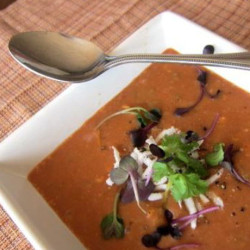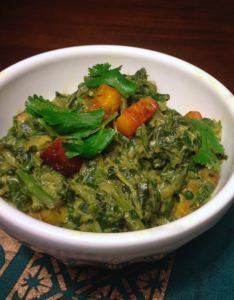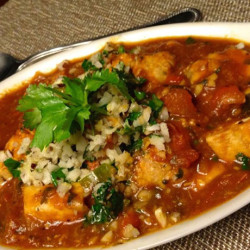Thursday, September 12, 2013
 It’s unusual for me to label a post with such a personal title, but in this case it is appropriate. If you’re a regular reader or have poked around my recipes page, you’ll see that I do a lot of global cooking with big flavors, including Indian food. I’ve always eaten and enjoyed cuisine from the Asian subcontinent but my skills have improved greatly with practice and experimentation. Particularly important has been the increased exposure to a broad range of South and North Indian cooking through my husband’s family and friends. At the center of it all was Pati, his beloved grandmother who passed away a few years ago at the age of 93. We lunched and Scrabbled with her regularly and one day we enjoyed a cooking lesson so I could learn a few of my husband’s favorites. I recently brought a few of these recipes together in my own way for an Indian-themed anniversary supper, the star of which was seared scallops with coconut chutney and tomato-tamarind sauce. (See photo at the bottom of this article.)
It’s unusual for me to label a post with such a personal title, but in this case it is appropriate. If you’re a regular reader or have poked around my recipes page, you’ll see that I do a lot of global cooking with big flavors, including Indian food. I’ve always eaten and enjoyed cuisine from the Asian subcontinent but my skills have improved greatly with practice and experimentation. Particularly important has been the increased exposure to a broad range of South and North Indian cooking through my husband’s family and friends. At the center of it all was Pati, his beloved grandmother who passed away a few years ago at the age of 93. We lunched and Scrabbled with her regularly and one day we enjoyed a cooking lesson so I could learn a few of my husband’s favorites. I recently brought a few of these recipes together in my own way for an Indian-themed anniversary supper, the star of which was seared scallops with coconut chutney and tomato-tamarind sauce. (See photo at the bottom of this article.)
Once you’ve got the coconut cracked open and shredded, this easy recipe has bold flavors, both savory and sweet, which can be used for and adapted to a variety of different dishes.
Coconut Chutney
Ingredients
 Fresh coconut and its juice, approximately half of each
Fresh coconut and its juice, approximately half of each- Green pepper (bell, poblano, anaheim, hatch, whatever), diced, 2-3 tbsp
- Ginger, grated, ~2-3 teaspoons
- Garlic, crushed, ~1-2 teaspoons
- Habanero or other hot red pepper, minced finely (optional, to taste)
- Green grams, split, 1/4 cup
- Cilantro, roughly chopped, 1-3 tbsp
- Asafoetida powder, 1-2 pinches
- Mustard seeds, ~1 teaspoon
- Salt, dash or two
Caveats. You’ll firstly notice, perhaps with exasperation, the approximation on quantities. This is for two reasons. First, like most experienced cooks, Pati didn’t measure (like me), so my husband and I did the best we could to jot down approximations as she prepared the chutney. Second, like many things you cook, particularly sauces and condiments, the final flavor profile is to taste. As long as you use the key ingredients above, always beginning with the smaller quantities, just nibble as you go along and prepare it as you like. Do know that the spices and aromatics are key ingredients, however.
Notes. Green grams, aka mung or moong beans or dal, were not in Pati’s original recipe, I must confess. But I had some left over for another purpose and added them, as they are commonly used in Indian dishes. It was delicious and also gave the chutney a protein and fiber boost. Rinse them in a few batches of cold water then cover with 3/4 cup water for 30 minutes until softened; they will retain a firm and somewhat chewy texture. Drain and add to the chutney.)
Instructions. After wrangling with the coconut to drain the water and crack open the shell—Don’t hurt yourself. Seriously.—break 1/2 to 3/4 into manageable chunks and finely chop in a food processor along with about half the coconut water; the innermost brown peel is perfectly edible. (I was saving the other half of the juice for another recipe; also, this is not a wet chutney. Use more if you prefer, but know that it will be drippy.) Transfer the damp coconut to a mixing bowl. Sauté the mustard seeds in a bit of vegetable oil until they crackle, then add to the mixture along with remaining ingredients. Taste and adjust seasonings and heat as desired.
This chutney is terrific in my savory roasted swordfish in tomato tamarind sauce or as a garnish for tomato tamarind soup. Both are absolutely amazing!
Also, my recipe makes about two cups, so I don’t recommend using the entire drupe unless you’re crazy about coconut chutney. It will keep in the fridge for a week or so, but keep in mind that, if you included hot peppers, the longer it sits the more fiery it will become.
I learned this the hard way.




